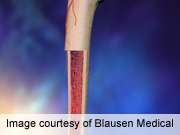For patients treated for Hodgkin's lymphoma, cumulative doses of alkylating agent is associated with the risk of therapy-related acute myeloid leukemia/myelodysplastic syndrome, according to a study published online Jan. 7 in the Journal of Clinical Oncology.
(HealthDay)—For patients treated for Hodgkin's lymphoma (HL), cumulative doses of alkylating agent (AA) is associated with the risk of therapy-related acute myeloid leukemia/myelodysplastic syndrome (t-AML/MDS), according to a study published online Jan. 7 in the Journal of Clinical Oncology.
Michael Zach Koontz, M.D., from the Stanford University Medical Center in California, and colleagues reviewed the records of 754 patients with HL (treated from 1974 to 2003) with at least five years of follow-up after completing therapy in successive generations of Stanford clinical trials. S studies (1974 to 1980) and C studies (1981 to 1989) utilized extended-field radiotherapy, while G studies (1989 to 2003) utilized involved-field radiotherapy. Primary chemotherapies varied by study.
The researchers found that, in the G studies, the cumulative exposure to AA was substantially lower than in the S and C studies, with a 75 to 83 percent lower dose of nitrogen mustard and omission of procarbazine and melphalan. t-AML/MDS developed in 24 patients, 15 following primary chemotherapy and nine after salvage chemotherapy for relapsed HL. G studies had a significantly lower incidence of t-AML/MDS (0.3 percent) compared with the S (5.7 percent) or C (5.2 percent) studies. No t-AML/MDS was seen in G studies after primary therapy. No patient from the G studies developed t-AML-MDS after primary therapy; t-AML/MDA developed in one patient from the G studies following second-line therapy.
"Our data demonstrate the relationship between the cumulative AA dose and t-AML/MDS," the authors write. "The prognosis for t-AML/MDS is dismal, and it is imperative that therapies minimize these risks."
One author disclosed financial ties to the pharmaceutical industry.
More information:
Abstract
Full Text (subscription or payment may be required)
Journal information: Journal of Clinical Oncology
Copyright © 2013 HealthDay. All rights reserved.


















